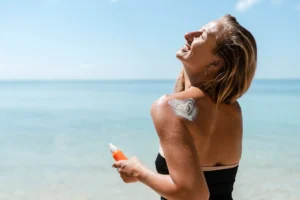Sunscreen is a cosmetic product used on the skin to protect it from the harmful effects of the sun’s ultraviolet rays. Sunscreens are made with substances that either absorb or reflect these rays before they reach the epidermis, the outer layer of the skin. The main function of sunscreen is to reduce the chance of the user’s skin being damaged by prolonged exposure to the sun. The ingredients in sunscreen block the sun’s penetration into the skin and protect it from damage.
Types of sunscreen in skin care:
Sunscreen can be physical or chemical.
Physical Sunscreen
They form an opaque coating where applied. These sunscreens contain zinc cream, calamine, and titanium oxide. The coating they create on the skin is opaque and dense, allowing ultraviolet rays to be reflected and scattered before reaching the skin. All of these physical sunscreens in skin care are termed “total block” because they create a hard coating on the skin, preventing both ultraviolet rays A and B from penetrating. The downside is that the hard coating this sunscreen forms on the skin doesn’t allow sweat to escape easily from the applied area. As a result, discomfort and a hot sensation may be felt in the area of use. For this reason, they are usually applied to small areas of the body, such as the lips, ears, and nose. Of course, if there is no discomfort, they can be applied anywhere on the body.
You may have noticed that cricket players from colder countries use this type of sunscreen on their nose, ears, and lips to protect themselves from the sun’s harmful effects while playing in hot countries. These sunscreens make the skin look white, so some formulations use dyes to avoid this effect. Many sunscreen companies also produce tinted products that can be used as foundations or powders to protect the skin from the sun’s rays. In a sense, makeup and dust can also act as sunscreen, although this depends on the density of use.
Chemical Sunscreen
Such sunscreen in skin care use one or more water-soluble or oil-soluble chemicals. All these chemicals absorb ultraviolet rays and reduce the intensity of sunlight. They cannot reflect and diffuse the sun’s rays like physical sunscreens, which is why this type of sunscreen formulation is more preferable. The two main chemical sunscreen groups are para-aminobenzoic acid and cinnamate derivatives. Although salicylate-group sunscreens in skin care are available, they are not very popular. Many sunscreens are labeled as SPF-6, SPF-12, SPF-25, etc. SPF actually means sun protection factor. This indicates how long a person can stay in the sun without experiencing sunburn, based on the SPF number. To clarify, suppose a person stays in the sun for 12 minutes and gets the first sunburn on the uncovered part of their body. By using sunscreen with SPF, they can stay in the sun for 10 times that amount of time, i.e., 120 minutes, without feeling any sunburn on the skin.
How to use sunscreen?
Always remember to use sunscreen in skin care on clean and dry skin. Using it on wet or sweaty skin may not provide the desired protection. Apply an even amount of sunscreen to the skin, avoiding uneven application. Sweat and water always interfere with the absorption of sunscreen, so clean and dry the area well before applying it. Water-resistant sunscreens should be applied half an hour before exposure to water; otherwise, they may wash off. Ideally, apply sunscreen after swimming and bathing. The last rule is that the effectiveness of sunscreen depends on how thickly it is applied—the thicker the application, the more protection the skin will have. Although there is no definitive evidence, sunscreen should not be used on children under the age of three.
